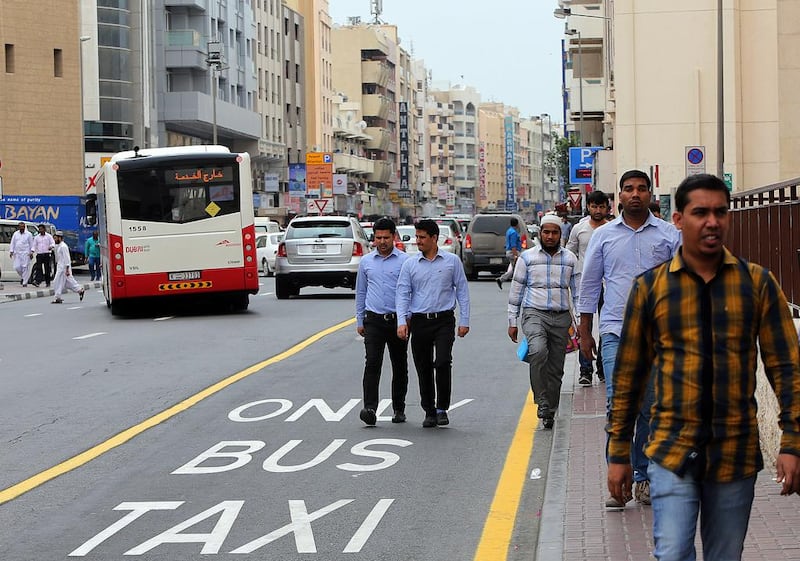DUBAI // Motorists filmed illegally using bus lanes will be hit with a Dh600 fine in a new measure to help ease congestion in busy areas of Dubai.
The fines are being introduced from April 1 after a successful three-month trial in Deira where a static roadside camera led to a 63 per cent drop in offending drivers.
Initially, cameras will be operating along a one-kilometre route along Naif Road, which is used by more than 300 buses a day on 20 different routes.
The Roads and Transport Authority (RTA) has installed seven smart-traffic cameras to monitor motorists, which can distinguish between public and private number plates. Offenders will be sent a text message, notifying them of the offence and fine.
“To ensure a smooth flow of other vehicles on the street, the RTA has designated about 20 metres of the street as a safe distance near exit points, turns and drop-off areas, to enable motorists to get out of this lane,” said Dr Yousef Mohammed Al Ali, chief executive of the RTA’s Public Transport Agency.
“The enforcement of the bus and taxi-only lanes system aims to increase the share of public transit in the movement of people in Dubai.
“It also aims to ease traffic congestion, improve efficiency of on-time bus arrivals, cut the duration of taxi trips, reduce direct and indirect operational costs of public transit, and cut carbon emissions polluting the environment.”
Public buses, taxis, police vehicles, civil defence vehicles, and ambulances on emergency calls are the only vehicles allowed in the lane. Private vehicles are permitted only to gain access to or exit subsidiary streets.
In 2010, the RTA introduced phase one of the bus and taxi lane system on a 6km stretch from Al Mankhool Street towards Al Ghubaiba Street.
A year later the project was extended to include parts of Naif Street and Ittihad Street in the direction from Sharjah towards Dubai, heading to Al Nahda interchange.
It is hoped the cameras will improve road safety by making motorists more aware of how they are driving and what is around them.
Sudden swerving was the leading cause of road deaths last year, followed by speeding, misjudgments made by road users, inattention, failure to comply with lane rules, and not letting pedestrians pass, according to the Traffic Coordination Department at the Ministry of Interior.
Most injuries were caused by not keeping enough distance from the vehicle in front, followed by jumping a red light, speeding, and entering a road without ensuring it was clear.
“We know from Ministry of Interior statistics that poor lane discipline and the incorrect use of lanes is one of the top 10 reasons for fatalities and injuries in the UAE.” said Thomas Edelmann, founder of Road Safety UAE.
“Anything like this to monitor drivers and make them think about where they are driving, and how that will effect other road users is good. A big problem is drivers using the hard shoulder or blocking lanes, which stops buses, taxis and emergency vehicles from turning. Not only does this cause more congestion but it is also dangerous.
“Hopefully cameras can be used to stop people from doing this in future.”
Although taxis will be allowed to enter the bus lanes, they will be prohibited from collecting or dropping off within the restricted zones. There are 33 bus lanes in Dubai, where police with mobile surveillance cameras currently monitor drivers.
“Naif Road was chosen for the study because it is one of the busiest for public transport, so it gave us a good indication of how successful the cameras were,” said Adel Shakri, director of planning and business development at the RTA.
“We will wait until the end of the year to assess the cameras’ performance before we decide if we can use them elsewhere in Dubai. We are also looking at other ways to reduce congestion, such as more cycle lanes.”
nwebster@thenational.ae







